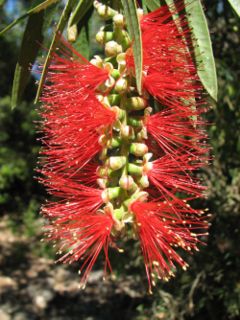
Callistemon is a genus of shrubs in the family Myrtaceae, first described as a genus in 1814. The entire genus is endemic to Australia but widely cultivated in many other regions and naturalised in scattered locations. Their status as a separate taxon is in doubt, some authorities accepting that the difference between callistemons and melaleucas is not sufficient for them to be grouped in a separate genus.

Melaleuca viminalis, commonly known as weeping bottlebrush, or creek bottlebrush is a plant in the myrtle family, Myrtaceae and is endemic to New South Wales, Queensland and Western Australia. It is a multi-trunked, large shrub or tree with hard bark, often pendulous foliage and large numbers of bright red bottlebrush flowers in spring and summer. It is possibly the most commonly cultivated melaleuca in gardens and its cultivars are often grown in many countries.

Melaleuca comboynensis, commonly known as cliff bottlebrush, is a plant in the myrtle family, Myrtaceae and is endemic to New South Wales and Queensland in Australia. It is usually a shrub, similar to Melaleuca citrina with its hard leaves, spikes of red flowers and clusters of cup-shaped fruits but differs in that its leaves are generally wider and its habitat is usually rocky outcrops rather than along watercourses.
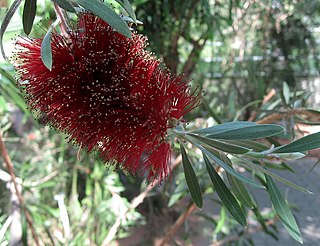
Melaleuca pachyphylla, commonly known as wallum bottlebrush, is a plant in the myrtle family, Myrtaceae and is endemic to near-coastal regions of New South Wales and Queensland in Australia. It is a medium-sized shrub with a straggling habit and red, or sometimes greenish bottlebrush flowers in summer.

Melaleuca phoenicea, commonly known as scarlet bottlebrush or lesser bottlebrush, is a plant in the myrtle family, Myrtaceae and is endemic to the south-west of Western Australia. The Noongar peoples know the plant as Tubada. It is a shrub with thick, blue-green leaves and spikes of scarlet bottlebrush flowers in spring and summer.

Melaleuca orophila, commonly known as needle bottlebrush or Flinders Ranges bottlebrush, is a plant in the myrtle family, Myrtaceae and is endemic to the eastern part of South Australia.. It is a medium-sized shrub with sharp-pointed, needle-like leaves and bright red bottlebrush flower spikes.
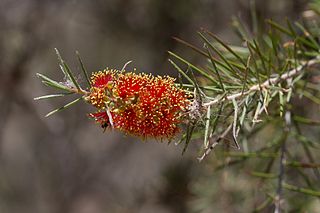
Melaleuca brachyandra, commonly known as prickly bottlebrush or scarlet bottlebrush, is a plant in the myrtle family, Myrtaceae and is endemic to New South Wales, Victoria and South Australia in Australia. It is a shrub or small tree with narrow leaves and showy red and green flowers making it an ideal ornamental plant in temperate areas.

Melaleuca recurva, commonly known as Tinaroo bottlebrush, is a plant in the myrtle family, Myrtaceae and is endemic to higher areas of far northern Queensland in Australia.. It is a shrub with spikes of red flowers tipped with yellow in most months of the year and which often has leaves with their edges curled under.

Melaleuca pallida, commonly known as lemon bottlebrush, is a plant in the myrtle family, Myrtaceae and is endemic to eastern Australia. It is an upright shrub with thin, spreading branches, silvery new growth and pale yellow, sometimes pinkish bottlebrush flowers.
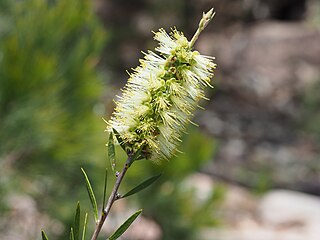
Melaleuca flavovirens, commonly known as green bottlebrush is a plant in the myrtle family, Myrtaceae and is endemic to a small area near the New South Wales–Queensland border in Australia. It is a stiff shrub, distinguished by its silvery new growth and spikes of greenish flowers with yellow tips.

Melaleuca formosa, commonly known as Kingaroy bottlebrush or cliff bottlebrush is a plant in the myrtle family, Myrtaceae and is endemic to a small area in Queensland and peripherally in New South Wales, Australia. It is a shrub with weeping branches and spikes of lemon-coloured flowers in spring.
Melaleuca hemisticta, commonly known as Mount Wheeler bottlebrush is a plant in the myrtle family, Myrtaceae and is endemic to coastal areas of Queensland. It is a tall, bushy shrub with dark green leaves and red flowers spikes tipped with yellow.

Melaleuca megalongensis, commonly known as Megalong Valley bottlebrush, is a plant in the myrtle family, Myrtaceae and is endemic to New South Wales.. It is a shrub similar to Melaleuca citrina which occurs in the same area and is difficult to distinguish from it, except when in flower.

Melaleuca montana, commonly known as mountain bottlebrush, is a plant in the myrtle family, Myrtaceae and is endemic to the Border Ranges area of New South Wales and Queensland in Australia.. It is a shrub or small tree distinguished from most other red bottlebrushes by its hairy petals.
Melaleuca montis-zamia is a plant in the myrtle family, Myrtaceae and is endemic to the Springsure district in Queensland, Australia. It is a shrub with red bottlebrush flowers.
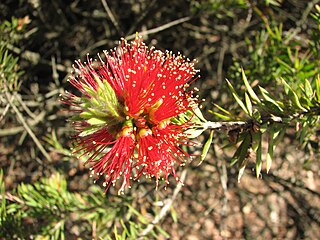
Melaleuca pearsonii, commonly known as Blackdown bottlebrush, is a plant in the myrtle family, Myrtaceae and is endemic to Queensland in Australia. It is a small, spreading but compact shrub with hard bark, soft foliage and profuse spikes of bottlebrush flowers in spring and summer.

Melaleuca polandii, commonly known as gold-tipped bottlebrush, is a plant in the myrtle family, Myrtaceae and is endemic a small area in far northern Queensland in Australia. It is a dense shrub with bronze-coloured, hairy new growth and spikes of red flowers tipped with yellow.
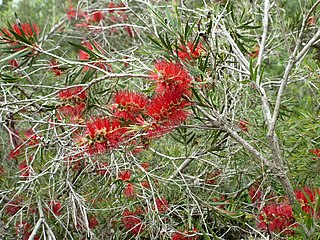
Melaleuca sabrina is a plant in the myrtle family, Myrtaceae and is endemic to a small area near the border between New South Wales and Queensland in Australia. It is a shrub with fibrous bark and red or pink bottlebrush flowers, tipped with yellow in spring and summer. It is similar to Melaleuca paludicola but distinguished from it by its stamens, which are almost twice as long as those of M. paludicola.

Melaleuca serpentina is a plant in the myrtle family, Myrtaceae and is endemic to the Barraba district in Australia. It is a shrub with yellow or creamy-green bottlebrush flowers. It is similar to Melaleuca citrina but can be distinguished from that species by its flower colour and its shorter stamens.

Melaleuca wimmerensis, commonly known as the Wimmera bottlebrush, is a plant in the myrtle family, Myrtaceae and is endemic to the state of Victoria in Australia.. It is a recently (2008) discovered shrub, often with many stems arising from a lignotuber and is similar to Melaleuca paludicola but has pink or mauve flowers tipped with yellow anthers over a short period between October and early December.



















